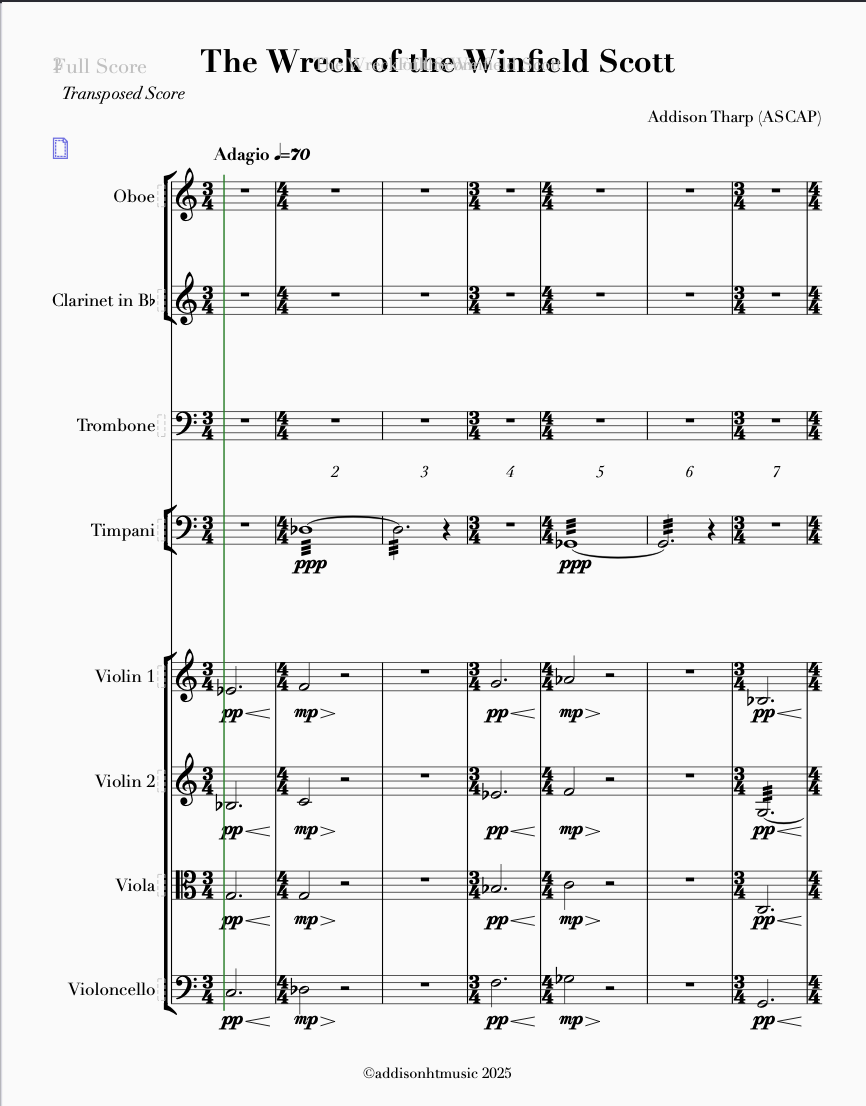 Image 1 of 1
Image 1 of 1


The Wreck of the Winfield Scott
Instrumentation: String Quartet, Bb Clarinet, Oboe, Trombone, Percussion (Timpani, Suspended Cymbal, Floor Tom)
The Wreck of the SS Winfield Scott occurred off the southern coast of California in 1853. During the California Gold rush of 1848, thousand of people swarmed to the state of California in search of wealth and fortune. In order to accommodate this influx of people, maritime activities including travel and shipping saw a boom due to the demands of the increased population. One of the leading companies was the Pacific Mail Steamship Company, in which the Winfield Scott was apart of. Departing from San Francisco, The vessel set sail for Panama and was loaded with more than 300 passengers and crew, mail, and over a million dollars in gold. A short while into the journey, Captain Simon. F. Blunt chose to pass through the Santa Barbara Channel, which would have saved the crew time on the journey. This mistake would prove costly due to the foggy conditions. Having navigated this course multiple times in the past, Blunt thought he knew the route but made a grave miscalculation. Blunt, thinking they had passed the Channel Islands, turned southeast which caused the Winfield Scott to crash into a rock off of Anacapa Island at full speed at around 11pm. Luckily the crew was able to escape with no fatalities, but the ship an its contents were lost to the bottom of the Pacific Ocean. This crash is now a popular diving location for visiters to the Channel Islands National Parks, and was the main contributors for the mandate of lighthouses on the California Coast. This piece emulates the calm before the crash, the chaos caused on the boat and escape, and the aftermath of the crash.
Instrumentation: String Quartet, Bb Clarinet, Oboe, Trombone, Percussion (Timpani, Suspended Cymbal, Floor Tom)
The Wreck of the SS Winfield Scott occurred off the southern coast of California in 1853. During the California Gold rush of 1848, thousand of people swarmed to the state of California in search of wealth and fortune. In order to accommodate this influx of people, maritime activities including travel and shipping saw a boom due to the demands of the increased population. One of the leading companies was the Pacific Mail Steamship Company, in which the Winfield Scott was apart of. Departing from San Francisco, The vessel set sail for Panama and was loaded with more than 300 passengers and crew, mail, and over a million dollars in gold. A short while into the journey, Captain Simon. F. Blunt chose to pass through the Santa Barbara Channel, which would have saved the crew time on the journey. This mistake would prove costly due to the foggy conditions. Having navigated this course multiple times in the past, Blunt thought he knew the route but made a grave miscalculation. Blunt, thinking they had passed the Channel Islands, turned southeast which caused the Winfield Scott to crash into a rock off of Anacapa Island at full speed at around 11pm. Luckily the crew was able to escape with no fatalities, but the ship an its contents were lost to the bottom of the Pacific Ocean. This crash is now a popular diving location for visiters to the Channel Islands National Parks, and was the main contributors for the mandate of lighthouses on the California Coast. This piece emulates the calm before the crash, the chaos caused on the boat and escape, and the aftermath of the crash.